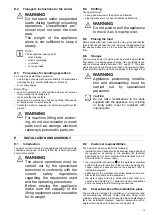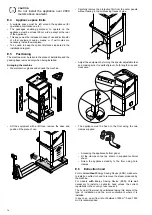
23
I.6
Residual risks
The machine has several risks that were not completely
eliminated from a design standpoint or with the installation of
adequate protection devices. Nevertheless, through this
manual the Manufacturer has taken steps to inform operators
of such risks, carefully indicating the personal protection
equipment to be used by them. In order to reduce the risks,
provide for sufficient spaces while installing the unit. To
preserve these conditions, the areas around the machine
must always be:
• kept free of obstacles (e.g. ladders, tools, containers, boxes,
etc.);
• clean and dry;
• well lit.
For the Customer's complete information, the residual risks
remaining on the machine are indicated below: such situations
are deemed improper and therefore strictly forbidden.
Residual risk
Description of hazardous
situation
Slipping or falling
The operator can slip due to water
or dirt on the floor
Catching, dragging or
crushing
Catching or dragging of the oper-
ator or other persons in the drive,
during the machine work phase,
due to improper actions, such as:
• placing an arm inside the
machine to remove a stuck rack
without stopping the machine
by operating an emergency
switch;
• accessing the rack handling
system without stopping the
machine by operating an emer-
gency switch.
Use of improper clothing with
loose parts (e.g. necklaces,
scarves, shawls, ties, etc.) or long
hair not gathered, which could get
caught up in moving parts.
Burns/abrasions (e.g.
heating elements,
cold pan, cooling cir-
cuit plates and pipes)
The operator deliberately or unin-
tentionally touches some
components inside the machine
without using protective gloves.
Stab wounds
The operator deliberately or unin-
tentionally touches some
components with sharp edges
during the machine cleaning with-
out using protective gloves.
Residual risk
Description of hazardous
situation
Burns
The operator deliberately or unin-
tentionally touches some
components inside the machine or
dishes at the outfeed without using
gloves or without allowing them to
cool.
Shearing of upper
limbs
The operator violently closes the
front panels.
Electrocution
Contact with live parts during
maintenance operations carried
out with the electrical panel
powered
Falling from above
The operator intervenes on the
machine using unsuitable systems
to access the upper part (e.g. rung
ladders, or climbs on it)
Crushing or injury
The specialised personnel may
not correctly fix the control panel
when accessing the technical
compartment. The panel could
close suddenly.
Crushing or shearing
Possible risk of injury to upper
limbs during the hood closing
operation.
Tipping of loads
When handling the machine or the
packing containing it, using unsuit-
able lifting systems or accessories
or with the unbalanced load
Chemical
Contact with chemical substances
(e.g. detergent, rinse aid, scale
remover, etc.) without taking
adequate safety precautions.
Therefore always refer to the
safety cards and labels on the
products used.
IMPORTANT
In case of a significant anomaly (e.g. short circuits,
wires coming out of the terminal block, motor
breakdowns, worn electrical cable sheathing, etc.)
the operator must immediately deactivate the
machine.
J
NORMAL MACHINE USE
J.1
Foreseen use
Our appliances are designed and optimised to ensure high
performance and efficiency. This equipment must only be used
for its expressly designed purpose, i. e. washing dishes with
water and specific detergents. Any other use is deemed
improper.
This appliance does not carry out the rinse cycle should there
be no supply water; it stops all functions with an error message
“A1“ (also see Alarms).
J.2
Operator qualified for normal machine
use
Must have at least:
• knowledge of the technology and specific experience in
operating the machine;
• adequate general basic education and technical knowledge
for reading and understanding the contents of the manual,
including correct interpretation of the drawings, signs and
pictograms;
• sufficient technical knowledge for safely performing his
duties as specified in the manual;
• knowledge of the regulations on work hygiene and safety.
In case of a significant anomaly (e. g. short circuits, wires
coming out of the terminal block, motor breakdowns, worn
electrical cable sheathing, etc.) the operator for normal
machine use must:
• immediately deactivate the machine by turning the switch
disconnector to “O“ or operating the main emergency switch
on the equipment;
• close the machine water supply by shutting off the water.
























